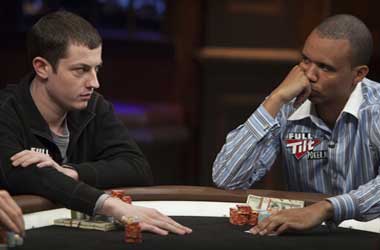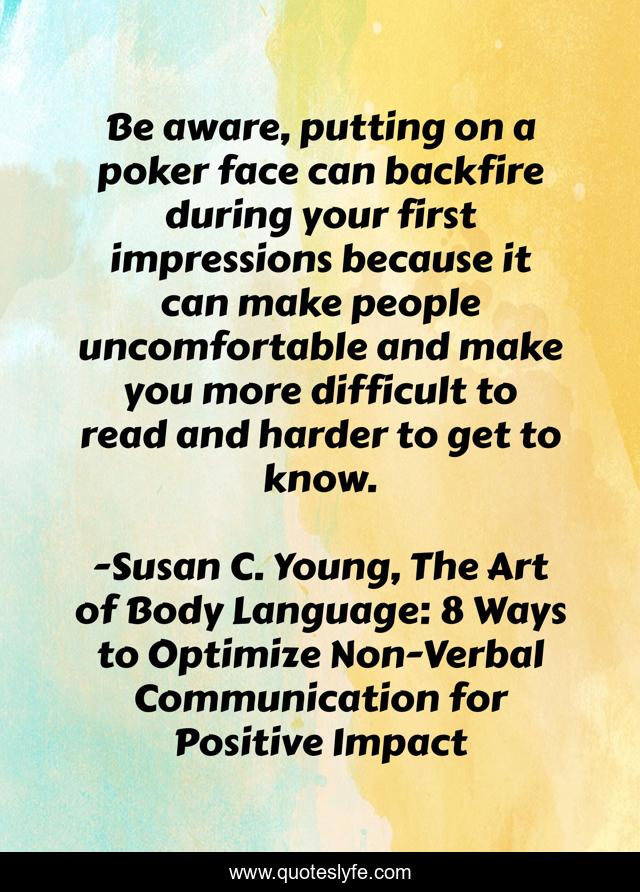Body Language Poker
If you want to increase the odds of victory drastically in your favor, learning body language just might be your ace in the hole. I know some of you are saying, “Well if I have a non-suited 7-2 and they have 4 of a kind they will almost definitely win! I doubt knowing body language and poker tells would help me then”. Poker Bluff: spot it with body language. Bluffing, whether you like it or not, is and will always be a part of any poker match. Making a successful bluff can give you not only good amount of money but also a very satisfying win. Imagine outsmarting your opponents with a very bad card—that will surely make your day. Live poker tells such as reading people’s reactions, body language, and subconscious signals can give you the edge against many opponents. And equally, knowing how to manipulate these psychological tendencies can help you throw your opponents off if you feel yourself playing in a predictable manner.
- Body Language Poker Tells
- Unwitting Body Language In Poker
- Reading Body Language Poker
- Body Language Poker Tells

If you decide to disconnect from virtual play for a while to play in alive setting, you need to think about how body language and physical appearanceare going to affect your performance. In a real-life setting, poker players tryto read other players by looking at the way they are dressed, the way they holdthemselves, and their facial expressions, so you need to be careful not to givethe wrong impression (unless you want to give them false tells, of course, butthat’s a risky strategy).
Body language, in the form of poker tells,is a great way to get information on an opponent’s strength/weakness. Find out how to use it to your benefit. Researchers have found that people more accurately understand mood when they examine body language, rather than facial expressions. “When people rated a whole image, it was clear to them – they saw winners and losers,” said Hillel Aviezer, now an assistant professor of psychology at the Hebrew University of Jerusalem.
I’m not saying you have to wear a big cowboy hat like those guys in poker movies,but you will need to think carefully about how you dress and how you’representing yourself to the other players at the table.
What to wear
The number one tip would probably be this: don’t try too hard! If you showup at a live poker game wearing a tuxedo like a James Bond wannabe, people arenot going to take you seriously. This isn’t a movie! Lots of poker playersfavor clothes that cover their faces, such as hoodies, hats, and sunglasses, asthese can help to minimize visible physical tells. But, conversely, they canalso draw attention to you, perhaps mark you out as someone who lacks theexperience to control their physical tells and might, in specificcontexts, be perceived as a sign of weakness.
Another potential downside to covering your face with hoods and glasses isthat you may be preventing yourself from using your facial expressions to givefalse tells. As we mentioned earlier, this can be a risky strategy, but ifyou’re an experienced live-action player and confident in your ability tomanipulate your opponents’ thinking with false physical tells, then ditch thesunglasses and hoodies.
You need to think carefully about all of these variables, where you’replaying, who you’re playing with, and what you feel comfortable wearing whenplanning your outfit for a live poker game. As it’s essential to stay relaxedand calm during a poker session, choosing clothes that you feel mostcomfortable in is probably the best approach.
Body language
The other factor in this equation is body language beyond the facial expressions mentioned above. It’s common to hear statements such as “80% of all communication is non-verbal,” and, while there is some debate on the exact figures, what is doubtlessly true is that non-verbal communication, i.e., body language, is incredibly important, especially in the context of a live-action poker game.
Strong = weak

A very general rule to follow is this: strong body language means the playerhas a weak hand, and weak or disinterested body language means the player has astrong hand. For instance, if a player puts on a brash and confident air whenmaking bets by raising their voice, slamming chips about, and being veryemphatic in their movements, then they may well be trying to overcompensate forweak cards. If, on the other hand, a player sighs dejectedly, folds their arms,and leans back from the table during play, they may well be sitting on a greathand.
These are very general rules of thumb, of course, and you’ll also need toobserve other player’s behavior over time, looking for patterns and trying toconstruct some frame of reference. Try and gauge what their normal behavior isand watch out for deviations from it, then you will start to get a moredefinite sense of how to interpret their body language.

Body Language Poker Tells
For example: what is their regular breathing pattern? Can you notice theirbreath becoming heavier or shallower? Do they like to maintain eye contact, ordo they prefer to look away? Is their general body language open, or closed?When you have established some reference points, you will notice when theirbehavior deviates from this norm, which may well indicate that the player isholding some good cards. Be observant of and responsive to changes in youropponents’ body language, and you could find yourself improving your game.
In short, poker is a complicated game, and successful players have to beable to process large amounts of information from several channels to win. Youropponents’ physical appearance is one of those channels. Tune in to it.
If you decide to disconnect from virtual play for a while to play in alive setting, you need to think about how body language and physical appearanceare going to affect your performance. In a real-life setting, poker players tryto read other players by looking at the way they are dressed, the way they holdthemselves, and their facial expressions, so you need to be careful not to givethe wrong impression (unless you want to give them false tells, of course, butthat’s a risky strategy).
I’m not saying you have to wear a big cowboy hat like those guys in poker movies,but you will need to think carefully about how you dress and how you’representing yourself to the other players at the table.
What to wear
The number one tip would probably be this: don’t try too hard! If you showup at a live poker game wearing a tuxedo like a James Bond wannabe, people arenot going to take you seriously. This isn’t a movie! Lots of poker playersfavor clothes that cover their faces, such as hoodies, hats, and sunglasses, asthese can help to minimize visible physical tells. But, conversely, they canalso draw attention to you, perhaps mark you out as someone who lacks theexperience to control their physical tells and might, in specificcontexts, be perceived as a sign of weakness.
Another potential downside to covering your face with hoods and glasses isthat you may be preventing yourself from using your facial expressions to givefalse tells. As we mentioned earlier, this can be a risky strategy, but ifyou’re an experienced live-action player and confident in your ability tomanipulate your opponents’ thinking with false physical tells, then ditch thesunglasses and hoodies.
You need to think carefully about all of these variables, where you’replaying, who you’re playing with, and what you feel comfortable wearing whenplanning your outfit for a live poker game. As it’s essential to stay relaxedand calm during a poker session, choosing clothes that you feel mostcomfortable in is probably the best approach.
Body language
The other factor in this equation is body language beyond the facial expressions mentioned above. It’s common to hear statements such as “80% of all communication is non-verbal,” and, while there is some debate on the exact figures, what is doubtlessly true is that non-verbal communication, i.e., body language, is incredibly important, especially in the context of a live-action poker game.
Strong = weak
A very general rule to follow is this: strong body language means the playerhas a weak hand, and weak or disinterested body language means the player has astrong hand. For instance, if a player puts on a brash and confident air whenmaking bets by raising their voice, slamming chips about, and being veryemphatic in their movements, then they may well be trying to overcompensate forweak cards. If, on the other hand, a player sighs dejectedly, folds their arms,and leans back from the table during play, they may well be sitting on a greathand.
Unwitting Body Language In Poker
These are very general rules of thumb, of course, and you’ll also need toobserve other player’s behavior over time, looking for patterns and trying toconstruct some frame of reference. Try and gauge what their normal behavior isand watch out for deviations from it, then you will start to get a moredefinite sense of how to interpret their body language.
Reading Body Language Poker
For example: what is their regular breathing pattern? Can you notice theirbreath becoming heavier or shallower? Do they like to maintain eye contact, ordo they prefer to look away? Is their general body language open, or closed?When you have established some reference points, you will notice when theirbehavior deviates from this norm, which may well indicate that the player isholding some good cards. Be observant of and responsive to changes in youropponents’ body language, and you could find yourself improving your game.
Body Language Poker Tells
In short, poker is a complicated game, and successful players have to beable to process large amounts of information from several channels to win. Youropponents’ physical appearance is one of those channels. Tune in to it.